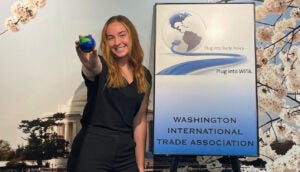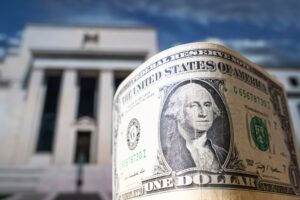Student Spotlight: Wandsnider Discovers Interest in Ag Trade at WITA
Meet Kate Wandsnider, a rising senior at the University of Nebraska-Lincoln majoring in Global Studies. Kate was this year’s recipient of the Steve Nelson Yeutter Institute International Trade Internship Award, which sends students to spend the summer interning at the Washington International Trade Association (WITA). Stay tuned for more information on the Husker Trade Talk Kate will host in the fall! Read more about Kate’s experience with WITA below.
Q&A with Kate Wandsnider
Tell us a little bit about yourself and your background.
I am a born and raised Nebraskan from Lincoln. I have always been interested in learning about and experiencing other cultures, so I chose to major in Global Studies, a highly interdisciplinary field that allows you to create a unique professional track. Later, I added two minors: Arabic Studies and Human Rights and Humanitarian Affairs. Last summer, I studied abroad in Amman, Jordan, where I worked on my Arabic language skills. This experience solidified my interest in working abroad in the future. I became interested in international trade when I learned about its role in global development. My internship this summer has shown me the many opportunities available through the trade community, and I am eager to explore those options.
08/12/2024 | Clayton Yeutter Institute | University of Nebraska–Lincoln
The Use of Economic Statecraft to Achieve Geopolitical Ends

On Thursday, September 12, WITA will host a panel event at this year’s WTO Public Forum in Geneva, Switzerland. The panel will explore how the WTO can help foster a circular economy for critical minerals. Find more information here and below.
The circular economy ‒ reusing materials and reducing waste ‒ is a critical strategy for delivering a lower-emission, more sustainable future. It’s the goal of countless regulatory initiatives, not least the United Nations Plastic Treaty currently under negotiation, and has been adopted as a key part of the business vernacular. However, despite this rising tide of corporate commitments and regulatory targets, the global economy remains wedded to an extractive, rather than circular, model.
Businesses have been slow to fully embrace circularity for multiple reasons, not least economics. There is money to be made from circularity, but allocating margins fairly across fragmented value chains is difficult. As the biggest beasts in the value chain – with the greatest capital and capability ‒ there is a compelling responsibility on commodity-producing companies to take a lead. However, corporate targets today remain stubbornly focused on individual companies, rather than on measures that would enable the entire circular value chain to thrive.
Companies need to explore different ways of building relationships across industries for circularity to flourish. In this report, we focus on three key initiatives across different industries – electronics, plastics and biofuels ‒ where companies have come together in precisely this manner, pointing a way forward for other sectors too. Through joined-up thinking, a pathway to increased circularity remains open.
Stuck in a loop: barriers to progress
A circular value chain is only as strong as its weakest link. If one company has no incentive to participate, the whole value chain can break down. In established, commoditised markets (such as gasoline), value allocation is coordinated by the price signal. However, in nascent, pre-commoditised markets typical of circular value chains (such as biofuels), transparency is lacking, presenting commercial challenges to businesses trying to make progress on circularity…
Read the Full White Paper Here
07/15/2024 | Guy Bailey & Husam Taha | Wood Mackenzie
The European Union’s Proposed Duties on Chinese Electric Vehicles and Their Implications
European Union countervailing duties (CVD) on certain types of electric vehicles (EVs) from China went into effect provisionally on 5 July. The duties are being imposed based on a European Commission finding that China’s EV subsidies represent potential injury to EU industry as it transitions away from the internal combustion engine. EU imports of EVs from China are surging, but still represent a small share of EU car sales. Most imports from China originate from joint ventures of EU and Chinese manufacturers, and from Tesla, which is the largest importer.
In the meantime, China is starting its own investigation into some EU exports, such as cognac. The EU has initiated consultations with the government of China to resolve the dispute, as it must do under the World Trade Organisation Subsidies and Countervailing Measures Agreement. Under WTO rules, China cannot retaliate unless it challenges the EU measure and a dispute settlement panel rules in its favour.
The CVDs range from 17.4 percent to 37.6 percent of the import price, on top of the EU’s 10 percent tariff on imported vehicles. They represent a formidable barrier in an industry where average profit margins are typically in the range of 4 percent to 8 percent. The CVDs will affect all EVs imported from China regardless of whether the original equipment manufacturer (OEM) is Chinese, American or European. Here, we offer an economic and political (as opposed to legal) analysis of the CVDs.
Methodology behind the CVDs
The Commission methodology for identifying subsidies and countervailing them is well established. Reflecting the importance of the EV sector, the regulation implementing the CVDs is the result of a comprehensive investigation, encompassing extensive consultations with Chinese firms, EU firms, the Chinese government and Chinese trade associations. Identifying subsidisation in China’s opaque system is challenging, especially since, as the regulation documents repeatedly, the Chinese government and several of the Chinese entities covered were uncooperative.
07/17/2024 | Uri Dadush & Conor McCaffrey | Bruegel
The Use of Economic Statecraft to Achieve Geopolitical Ends
With headlines dominated by geopolitical events, policymakers overlook the true threat to US success—the dollar as the world’s global reserve currency. As the anchor of the global economic order, America’s command over the world-reserve currency and dollar-denominated assets is unrivaled. The US dollar is the basis of international trade and investment, which gives America enormous global influence, promoting US commercial interests and universal principles like democratization and human rights.
American economic strength and dynamism allow the United States to extend its global influence through non-kinetic means, while also accruing additive benefits. The United States, despite its debt and political turmoil, remains attractive for foreign direct investment, immigration, and as a business partner. The United States has a well-earned reputation for a laissez-faire approach to private capital that has made it a global financial hub, sometimes to the chagrin of Congress as it seeks to ban some Chinese companies from listing in US markets.
In the current world order, capital moves across borders with few limitations. Steps taken to slow the flow of capital starve countries of investment and inflict costs on economic growth, employment, tourism, tech transfer, and global opportunities. The same would be true for the United States unless policymakers take economic statecraft seriously. The dollar provides America with a unique competitive advantage that the euro, yen, and yuan have yet to displace. That status is not a given though as domestic polarization (playing on fear) and financial and corporate interests (playing on greed) have the potential to erode USD status.
Policymakers are taking notice.
National Security Advisor Jake Sullivan’s April 27, 2023 speech provided a broad framework for economic statecraft as the avenue for renewal of America’s economic leadership. Unfortunately, it also led to concerns that poorly crafted or blunt-tool economic statecraft are likely to lead to bad policy, which ultimately serve to undermine the greenback and lead to further acceleration of de-dollarization. Concerns about de-dollarization in the near term are overblown, but that does not mean that those concerns shouldn’t be heeded. There are significant dollar shortages in African, South Asian, and South American emerging markets, leading them to trade in non-USD currencies.
08/14/2024 | Janine Stouse | Foreign Policy Research Institute
WITA – We put the community in trade community.
Information about upcoming WITA and trade community events





